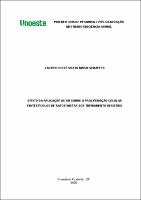| Compartilhamento |


|
Use este identificador para citar ou linkar para este item:
http://bdtd.unoeste.br:8080/jspui/handle/jspui/1374| Tipo do documento: | Dissertação |
| Título: | Efeito da aplicação de GH sobre a proliferação celular em testículos de ratos Wistar submetidos ao hormônio do crescimento sob treinamento resistido |
| Título(s) alternativo(s): | Effect of GH application on cell proliferation in Wistar rats testicles submitted to growth hormone under resisted training |
| Autor: | Schaffer, Lauren Chrys Soato Marin  |
| Primeiro orientador: | Giometti, Ines Cristina |
| Primeiro membro da banca: | Pacagnelli, Francis Lopes |
| Segundo membro da banca: | Cardoso, Ana Paula Mattoso Miskulin |
| Resumo: | O hormônio do crescimento (GH) é frequentemente utilizado de forma indiscriminada por indivíduos que buscam um melhor desempenho físico, com finalidade de aumentar a massa muscular, o que pode levar a efeitos não desejados ao organismo. O objetivo do presente estudo foi investigar a proliferação celular e a expressão gênica ligadas à multiplicação celular em testículos de ratos Wistar que foram submetidos ao hormônio do crescimento sob treinamento resistido. Foram utilizados 32 ratos machos Wistar, com idade de 9 semanas, divididos em 4 grupos experimentais: CG (grupo controle, n=8); GHG (grupo de animais em que se administrou 0,2 UI/Kg de GH, 3 vezes por semana por 30 dias, n=8); TG (grupo de animais submetidos ao treinamento resistido, 4 séries de 10 saltos em água com 50% do peso do animal, 3 vezes por semana durante 30 dias, n=8) e GHTG (grupo de animais submetidos ao treinamento resistido e à administração de GH, n=8). Após a eutanásia dos ratos, os testículos foram coletados para verificar a proliferação celular pela técnica de AgNOR e para a RT- qPCR dos genes-alvo Ghr, Igf1 e Igf2. A análise estatística dos dados foi ANOVA seguida de Tukey, diferença estatística significativa foi considerada com p<0,05. Os ratos do GHG apresentaram maior ganho de peso que os demais grupos e maior peso testicular que o GHTG (p<0,05). Não houve diferença significativa na contagem de regiões organizadoras de nucléolos e na área dos núcleos e dos nucléolos. Também não houve diferença significativa na expressão dos genes-alvo. A realização do experimento se justifica para saber se o uso de GH em ratos machos haveria multiplicação celular e se o uso do GH juntamente com o treinamento resistido afetaria geneticamente o sistema reprodutor masculino. Concluiu-se que a aplicação de GH sob treinamento resistido não alteram a proliferação celular testicular nem a expressão gênica de Ghr, Igf1 e Igf2 nos testículos de ratos Wistar no período analisado. |
| Abstract: | Growth hormone (GH) is often used indiscriminately by individuals looking for better physical performance, in order to increase muscle mass, which can lead to unwanted effects on the body. The aim of the present study was to investigate cell proliferation and gene expression linked to cell multiplication in testicles of Wistar rats that were subjected to growth hormone under resistance training. 32 male Wistar rats, aged 9 weeks, were used, divided into 4 experimental groups: CG (control group, n = 8); GHG (group of animals administered 0.2 IU / kg of GH, 3 times a week for 30 days, n = 8); TG (group of animals submitted to resistance training, 4 series of 10 jumps in water with 50% of the animal's weight, 3 times a week for 30 days, n = 8) and GHTG (group of animals submitted to resistance training and administration GH, n = 8). After the mice were euthanized, the testicles were collected to check for cell proliferation by the AgNOR technique and for the RT-qPCR of the target genes Ghr, Igf1 and Igf2. The statistical analysis of the data was ANOVA followed by Tukey, a statistically significant difference was considered with p <0.05. GHG rats showed greater weight gain than the other groups and greater testicular weight than GHTG (p <0.05). There was no significant difference in the count of nucleolus organizing regions and in the area of nucleus and nucleolus. There was also no significant difference in the expression of the target genes. The experiment is justified to find out if the use of GH in male rats would have cell multiplication and if the use of GH together with resistance training would genetically affect the male reproductive system. It was concluded that the application of GH under resistance training does not alter the testicular cell proliferation or the gene expression of Ghr, Igf1 and Igf2 in the testicles of Wistar rats in the analyzed period. |
| Palavras-chave: | AgNOR. Exercício físico. GH. Reprodução. RT-qPCR. AgNOR. Physical exercise. GH. Reproduction. RT-qPCR. |
| Área(s) do CNPq: | CIENCIAS AGRARIAS::MEDICINA VETERINARIA |
| Idioma: | por |
| País: | Brasil |
| Instituição: | Universidade do Oeste Paulista |
| Sigla da instituição: | UNOESTE |
| Departamento: | Mestrado em Ciência Animal |
| Programa: | Mestrado em Ciência Animal |
| Citação: | Schaffer, Lauren Chrys Soato Marin. Efeito da aplicação de GH sobre a proliferação celular em testículos de ratos Wistar submetidos ao hormônio do crescimento sob treinamento resistido. 2020. 56f. Dissertação (Mestrado em Ciência Animal) - Universidade do Oeste Paulista, Presidente Prudente, 2020. |
| Tipo de acesso: | Acesso Aberto |
| URI: | http://bdtd.unoeste.br:8080/jspui/handle/jspui/1374 |
| Data de defesa: | 15-Mai-2020 |
| Aparece nas coleções: | Mestrado em Ciência Animal |
Arquivos associados a este item:
| Arquivo | Descrição | Tamanho | Formato | |
|---|---|---|---|---|
| Lauren Chrys Soato Marin Schaffer.pdf | Lauren Chrys Soato Marin Schaffer | 860,03 kB | Adobe PDF |  Baixar/Abrir Pré-Visualizar |
Os itens no repositório estão protegidos por copyright, com todos os direitos reservados, salvo quando é indicado o contrário.




